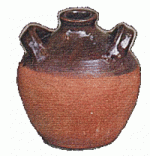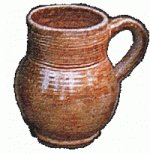Navigation
Install the app
How to install the app on iOS
Follow along with the video below to see how to install our site as a web app on your home screen.
Note: This feature may not be available in some browsers.
More options
You are using an out of date browser. It may not display this or other websites correctly.
You should upgrade or use an alternative browser.
You should upgrade or use an alternative browser.
✅ SOLVED Anybody good with pottery?
- Thread starter JohnDee1
- Start date
Squirrel322
Silver Member
- Jul 4, 2016
- 4,418
- 9,426
- Detector(s) used
- E-Trac, Equinox 800, Go-Find 66, ACE 250
- Primary Interest:
- All Treasure Hunting
I thought maybe a raku fire pot but it looks like its glazed so idk.....
Upvote
0
Oroblanco
Gold Member
- Jan 21, 2005
- 7,841
- 9,848
- Detector(s) used
- Tesoro Lobo Supertraq, (95%) Garrett Scorpion (5%)
Can you post a photo showing the broken edge of a piece? It might help to see the type of clay it was made from. I was thinking perhaps Susquehannock but I need to see the clay. Thanks in advance, cool find!
Upvote
0
I'm no expert when it comes to Colonial American pottery, but I'm thinking what you have there is an early 'redware' pot. 
Dave
"The earliest American pottery of some interest was first made in the State of Pennsylvania, in the mid-eighteenth century. Though practically all pottery objects made were required for everyday use of the early colonial settlers of the 17th century, none was made with any form of decorative patterning except perhaps for an imprinted mark that identified one owner from another. Understanding the types of pottery that have been made in or imported to America can be difficult to sort through. The average New England household in the 17th century could contain an assortment of ceramics from Europe, the Mediterranean and the Orient. Trade up and down the Atlantic coast was taking place among the Dutch, English and Spanish. The inventories of early 17th century New England households in the Boston area have shown to contain Dutch and English delft, Italian, Spanish and Portuguese majolica, porcelain, imported redware and locally manufactured redware.
Redware is a type of earthenware. What causes the red color is the amount of iron in the clay body. Other minerals can affect the color as well, but iron is the major mineral to affect color. Redwares can range from light orange to dark brown in color and the clay body can be fine grained to coarse. Redware clay deposits occur close to the surface and can be used as they are after processing. The color of the clay as it comes out of the ground can very greatly from the finished pot. Often, redware clays in New England are grey in color until after firing at which time many of them range from bright orange to deep red brown. During the 17th and 18th centuries, locally produced redware was usually utilitarian and sometimes of poor quality. From the 1680s through the Revolutionary War potters were restricted by the British from making fancier wares and could only make the more basic forms such as chamber pots, pans, butter pots and other common pieces found in the kitchen and pantry. These types of wares were not economical to ship from Europe and so local production was tolerated. Refined redwares, most stoneware and all porcelain and tin-glazed wares were imported into the American colonies until the end of the Revolutionary War."
Dave
"The earliest American pottery of some interest was first made in the State of Pennsylvania, in the mid-eighteenth century. Though practically all pottery objects made were required for everyday use of the early colonial settlers of the 17th century, none was made with any form of decorative patterning except perhaps for an imprinted mark that identified one owner from another. Understanding the types of pottery that have been made in or imported to America can be difficult to sort through. The average New England household in the 17th century could contain an assortment of ceramics from Europe, the Mediterranean and the Orient. Trade up and down the Atlantic coast was taking place among the Dutch, English and Spanish. The inventories of early 17th century New England households in the Boston area have shown to contain Dutch and English delft, Italian, Spanish and Portuguese majolica, porcelain, imported redware and locally manufactured redware.
Redware is a type of earthenware. What causes the red color is the amount of iron in the clay body. Other minerals can affect the color as well, but iron is the major mineral to affect color. Redwares can range from light orange to dark brown in color and the clay body can be fine grained to coarse. Redware clay deposits occur close to the surface and can be used as they are after processing. The color of the clay as it comes out of the ground can very greatly from the finished pot. Often, redware clays in New England are grey in color until after firing at which time many of them range from bright orange to deep red brown. During the 17th and 18th centuries, locally produced redware was usually utilitarian and sometimes of poor quality. From the 1680s through the Revolutionary War potters were restricted by the British from making fancier wares and could only make the more basic forms such as chamber pots, pans, butter pots and other common pieces found in the kitchen and pantry. These types of wares were not economical to ship from Europe and so local production was tolerated. Refined redwares, most stoneware and all porcelain and tin-glazed wares were imported into the American colonies until the end of the Revolutionary War."
Attachments
Last edited:
Upvote
0
Reanm8er
Bronze Member
- Aug 17, 2018
- 2,283
- 3,556
- Detector(s) used
- WW2 Mine Detector, 2 Garrets and an Underwater Fisher (Older Machines)
- Primary Interest:
- All Treasure Hunting
Nice finds John!
What Dave said absolutely. The first two settlers in the area that would become my home town were a potter that ran a tavern
and the other a tanner. Another of their popular products was the salt safe. An open bowl that hung on the wall with a wooden or clay top.
It helped to keep the salt from caking by getting it above the moisture layer. My area is in a huge limestone belt with iron
deposits so we had multiple colors of clay and many potters. You may have had a pottery or a business like a tavern on your
property that used and broke a lot of drinking vessels. The scraps would probably make a cool and colorful collection.
Dig carefully and sift everything. Best wishes!
What Dave said absolutely. The first two settlers in the area that would become my home town were a potter that ran a tavern
and the other a tanner. Another of their popular products was the salt safe. An open bowl that hung on the wall with a wooden or clay top.
It helped to keep the salt from caking by getting it above the moisture layer. My area is in a huge limestone belt with iron
deposits so we had multiple colors of clay and many potters. You may have had a pottery or a business like a tavern on your
property that used and broke a lot of drinking vessels. The scraps would probably make a cool and colorful collection.
Dig carefully and sift everything. Best wishes!
Upvote
0
- Thread starter
- #6
Thanks for the responses guys! I had started to wonder if some of the sherds were locally made, and the fact it could be that old is fascinating. Something about pottery makes it a more personal connection to past inhabitants of a land, than say a nail. Of course that's just may opinion. But regardless thanks again!
Upvote
0
Top Member Reactions
-
 3613
3613 -
 2006
2006 -
 1785
1785 -
 1454
1454 -
 1232
1232 -
 1175
1175 -
 1076
1076 -
 966
966 -
 838
838 -
 733
733 -
 638
638 -
 577
577 -
 483
483 -
 477
477 -
 461
461 -
E
433
-
 391
391 -
 390
390 -
 384
384 -
 356
356
Users who are viewing this thread
Total: 2 (members: 0, guests: 2)
Latest Discussions
-
🏺🏺🧩🧩🐷🐷 Metal Detecting could trigger some pieces and convert in Art🏺🧩🐷
- Latest: Silvermonkey
-
-
-












